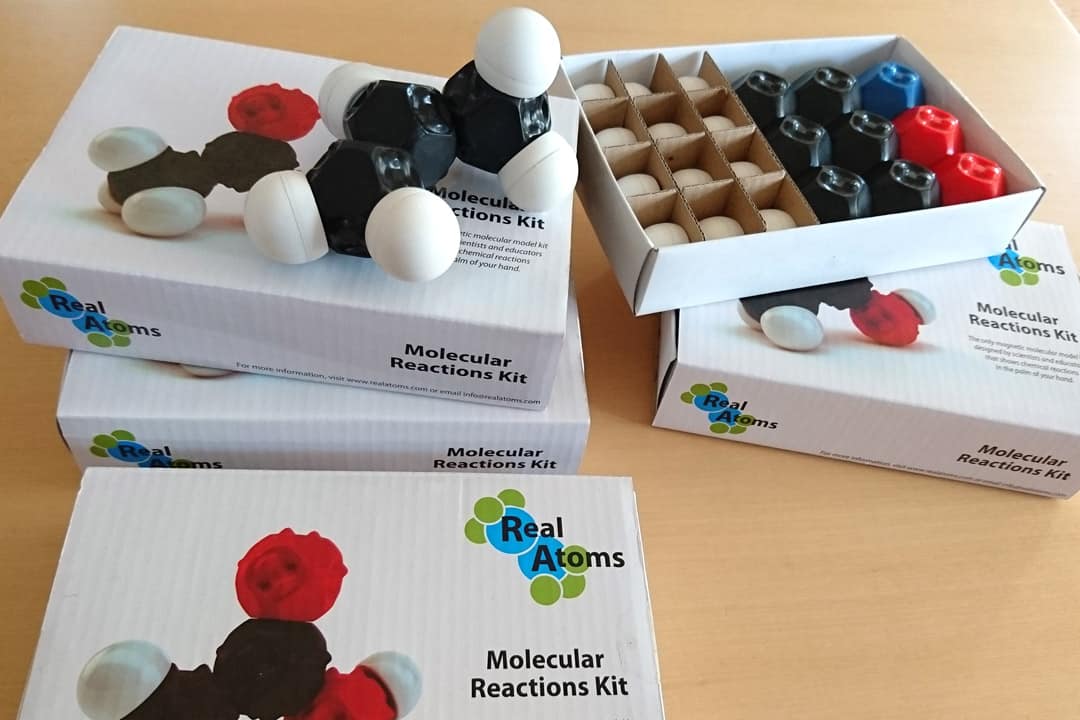Around this time of year, students purchase molecular model kits from the bookstore. These kits come with parts to create ball-and-stick models, but they are rigid and rather unreflective of the dynamic reactions taught in courses like organic chemistry.
“You have a visual picture of atoms shuffling around, and it’s very hard to communicate it in undergraduate classes,” says Professor Ulrich Fekl of UTM’s Department of Chemical and Physical Sciences.
For instance, in existing model kits, the carbon atom can only form four bonds, and the models are unable to show chemical reactions and intermediates.
As such, teaching reactions and mechanisms becomes difficult for instructors, who could resort to animations and videos, but this approach lacks a tactile experience.
This lack of flexibility is what inspired Fekl and U of T alum Joshua Moscattini to found RealAtoms.
“I always have this mental picture of atoms rearranging and it’s really, really smooth, and there is something enjoyable and memorable about touching models,” says Fekl. But “rearranging and the tactile experience don’t mesh with the existing kits.”
RealAtoms is a dynamic molecular model kit developed with the goal of being able to model and visualize organic and inorganic chemistry reactions, including their intermediates.
The kit comes with 12 hydrogens, six carbons, one nitrogen, and two oxygens. The carbons, nitrogen, and oxygens all have the same composition and can be used interchangeably.
“We call it the molecular reaction kit,” says Fekl.
Fekl developed prototypes of the molecular kit with support from his department, its Chair Claudiu Gradinaru, as well as the Impact Centre.
Moscattini, who is a sessional instructor at U of T and Professor at Seneca College, used his ten years of design experience to help develop RealAtoms using 3D Design.
With RealAtoms there are more possibilities. SN2 reactions can be observed in the hands of the user. The atoms of this kit are capable of showing the entire process from a nucleophilic attack, a five-coordinate carbon representing the intermediate, and finally the exit of the leaving group.
The Walden inversion — the conversion of a molecule from one enantiomer to another — cannot be demonstrated using current model kits, but can be done with RealAtoms with ease.
The kit can also be used for inorganic studies. The atoms in the kit are also able to form transition metal complexes and show square planar and octahedral geometries, and can be used to create lattice structures, and organic and inorganic molecules.
Unlike typical ball-and-stick models, parts in the RealAtoms kit contain magnets enclosed in ABS plastic. According to Fekl, magnetic model kits can already be purchased, but the magnets in the kits don’t contribute to their function.
The magnets used in RealAtoms are functional and allow users to quickly assemble and change a molecule’s geometry.
The model kit also allows users to feel the resistance when rotating bonds.
The model clearly shows that the single bonds of sp3 hybridized carbons can freely rotate, while the double bonds of sp2 hybridized carbons, which cannot rotate.
To form molecules with double or triple bonds, traditional ball-and-stick models would require completely different sticks to form them. The molecule must also be taken apart in order to transition between the different geometries.
However, the atoms in the RealAtoms model kit contain plane surfaces along with concave and convex surfaces. These surfaces, contributed by Moscattini, lock in the orientation of a molecule to prevent rotation around the double bond.
Fekl and Moscattini hope to create a new standard for organic and inorganic model kits.
The model kit became commercially available for the first time at the 2018 Canadian National Exhibition. Moscattini delivered a pitch that won the Kids Technology Pitch Competition. It is also currently being used in a study at Seneca College to investigate the benefits of model kits in chemistry education.
“The overall goal, I think, is for this to be the new standard in terms of organic model kits and inorganic kits,” says Moscattini. “We’re aiming for that, to have it in classrooms across Canada and the rest of North America.”


